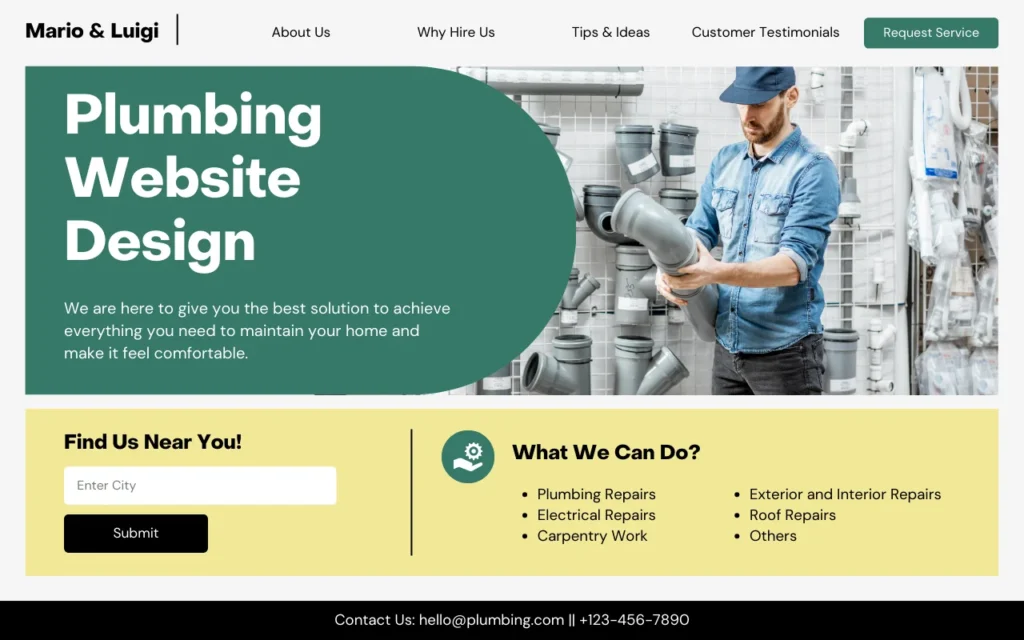If you want more calls, more booked jobs, and less time waiting for work, it’s time to optimize your plumbing website. By making a few smart tweaks—like targeting the right local keywords, polishing your Google Business profile, and building trust with reviews—you can show up when customers in your area are searching and ready to hire.
Understanding Local SEO for Plumbing
Definition of Local SEO
The core of Local SEO revolves around optimizing your online presence to attract more business from relevant local searches. This specialization of search engine optimization (SEO) focuses on making your plumbing business visible to users who are looking for plumbing services in your immediate geographic area. Local SEO uses various strategies, including keyword optimization, local business listings, and local backlinks, to ensure your plumbing website ranks high in search results for local queries.
While traditional SEO strategies aim to bring traffic from a broad audience, Local SEO is distinctly different. It targets consumers who are already seeking plumbing services in specific locales, thereby increasing the likelihood of converting searchers into paying customers. In the plumbing industry, where the needs are often immediate and service area-based, leveraging Local SEO can help you connect with potential clients right when they need assistance.
Importance of Local SEO for Plumbing Businesses
You may wonder why Local SEO should be a priority for your plumbing business. The answer lies in the increasing trend of consumers using search engines to find local services. When a potential customer types “plumber near me” into Google, they are looking for immediate solutions. By optimizing your website for local search, you increase your chances of being seen by such customers at the moment they are ready to make a decision.
A strong Local SEO strategy allows your plumbing business to stand out from the competition. Understanding local rankings, claiming your Google My Business listing, and garnering positive customer reviews are crucial for establishing credibility and trust. When you optimize for Local SEO, you not only heighten your visibility but also enhance customer engagement, ultimately leading to increased conversions and long-term business growth.
How to Perform Local SEO Keyword Research
It’s crucial for your plumbing website to rank well in local searches, and this starts with effective keyword research. In the plumbing industry, targeting the right local keywords can significantly enhance your online visibility, drawing potential customers who are actively seeking your services in your specific area. This is especially important as most individuals today turn to the internet to find local service providers, making your choice of keywords pivotal to your SEO strategy.
Identifying Relevant Keywords for Plumbing
To begin identifying relevant keywords for plumbing, you want to focus on terms that your local customers are likely using. Start by brainstorming common plumbing services you offer, such as “emergency plumbing,” “drain cleaning,” or “leak repair.” Consider incorporating your location into these terms, such as “emergency plumbing in [Your City].” This will help you connect with customers who are looking for specific services within your geographical area, ensuring that your website appears in relevant search results when potential customers need assistance.
Additionally, think about the problems your customers frequently encounter. If you’re offering solutions to common plumbing issues, include keywords related to those problems as well. For instance, terms like “fixing a leaky faucet” or “clogged toilet solutions” may attract local traffic looking for immediate answers. By identifying keywords that are both service-oriented and problem-specific, you’ll create a strong foundation for your local SEO efforts.
Optimize Your Plumbing Website by Utilizing Tools for Effective Keyword Research
Utilizing tools for effective keyword research can provide you with invaluable insights and guidance in selecting the best keywords for your plumbing website. Platforms like Google Keyword Planner, SEMrush, and Ahrefs allow you to see local search volumes, competition levels, and related keywords, which can help you to refine your keyword list. These resources not only tell you what terms people are searching for but also help you discover new keywords that you might not have considered.
Moreover, these tools can assist you in identifying long-tail keywords, which are typically less competitive and can drive more targeted traffic to your site. For instance, instead of competing for a generic term like “plumber,” consider phrases like “affordable plumber near me” or “best plumbing service in [Your Area].” By focusing on specific, localized keywords, you can capture the attention of users who are more likely to convert into customers.
Tools like keyword analysis software can also help in tracking the performance of your chosen keywords over time. This kind of ongoing analysis is vital for optimizing your local SEO strategy and adjusting your focus as new trends or keywords emerge that might be relevant to your plumbing services.
Analyzing Competitor Keywords
Keyword analysis can significantly enhance your SEO strategies, especially when you look closely at your competitors. Start by identifying local plumbing businesses that rank highly in your area and explore the keywords they are using. Tools like SEMrush and Moz can help in providing insights into your competitors’ keyword strategies, helping you understand what terms might be effective for your own website. By analyzing the keywords that drive traffic to their sites, you’ll be able to identify gaps in your own keyword strategy and capitalize on opportunities to outmaneuver them.
Additionally, pay attention to the content your competitors are producing around those keywords, such as blog posts or service pages. This can inspire ideas for your own content and help you position your services more effectively in a way that resonates with your local audience. Capitalizing on keywords they’ve missed or creating better content around shared keywords can help your plumbing website climb higher in local search results.
Plus, remember that keeping an eye on your competitors is an ongoing process. Trends in searches can change, especially in the plumbing industry where seasonal concerns can affect demand for certain services. Regularly analyzing your competitors’ keywords can help you stay agile and adapt your local SEO strategy to maintain a competitive edge.
Tips for Optimizing Your Plumbing Website
Despite the increasing competition in the plumbing industry, optimizing your website for local SEO can significantly enhance your online visibility and attract more customers. By implementing a few key strategies, you can ensure that your plumbing services stand out in local search results, driving more traffic to your site and ultimately leading to increased bookings.
- Ensure NAP (Name, Address, Phone Number) consistency across all platforms
- Utilize relevant local keywords throughout your content
- Engage with local online communities and forums
- Establish your business on Google My Business and other local directories
- Encourage and manage customer reviews
This comprehensive approach will not only improve your search rankings but also enhance your credibility in the eyes of potential customers.
Optimizing Title Tags and Meta Descriptions
If you want your plumbing website to rank higher in local searches, start by optimizing your title tags and meta descriptions. Title tags should be concise, descriptive, and feature your primary keywords along with local identifiers such as the city or neighborhood you service. Similarly, your meta descriptions should provide a compelling summary of your services and entice users to click through to your site, while incorporating relevant keywords and geographical information.
Additionally, it’s imperative to keep your title tags under 60 characters and your meta descriptions within 155 characters for optimal display on search engines. This ensures that your content is not truncated and is fully readable for potential customers, which can boost click-through rates.
Crafting SEO-Friendly Content
yes hwebsite’s content is critical for local SEO success. Focus on creating informative, engaging, and original content that addresses the unique plumbing needs of your local audience. By incorporating relevant keywords naturally throughout your articles or service pages, you can optimize your content for search engines while also providing valuable information to your readers.
Furthermore, consider including localized references in your content. This could mean mentioning local landmarks, common plumbing issues in your area, or even case studies of projects you’ve completed locally. This not only enhances the relevance of your content but also builds trust with potential customers who appreciate local expertise.
Plus, regularly updating your content and adding blog posts related to plumbing tips or how-to guides can position you as an authority in your field, which enhances your credibility and helps with SEO rankings.
Using Localized Landing Pages
Localized landing pages are a powerful tool for enhancing your local SEO strategy. By creating specific landing pages for each service area you serve, you enable search engines to better understand your geographical reach. Each page should include local keywords and content tailored to the specific neighborhood or city, highlighting your plumbing services that cater to the community.
Incorporating testimonials, case studies, and gallery images from your work in those areas can further enrich the content, making it not only relevant but also engaging for visitors. This strategy ultimately increases your chances of ranking higher in search results for localized queries.
Descriptions of services should clearly address the unique plumbing challenges faced in different localities, thus providing answers to potential customers who are searching for localized plumbing solutions. Customizing your content this way strengthens your connection to the community.
Incorporating Calls-to-Action (CTAs)
Tips for effectively incorporating calls-to-action (CTAs) into your plumbing website cannot be overlooked. CTAs guide your visitors on what to do next, whether that’s making a phone call, filling out a contact form, or scheduling a service. Strategically placed CTAs throughout your website can lead to increased conversion rates as they provide clear directions for potential customers.
Ensure your CTAs are visually distinct and use action-oriented language that encourages immediate engagement, such as “Get a Free Estimate Today!” or “Contact Us for Expert Plumbing Services.” Place them in prominent locations, such as the top of your homepage, at the end of blog posts, or in sidebars, so they are easily visible to users.
Using compelling CTAs connects potential customers with your services seamlessly. As they navigate through your content, clear and persuasive calls-to-action can significantly influence their decision-making process, ultimately driving conversions and growing your customer base.
Factors Influencing Google My Business Ranking
Now that you understand the basics of local SEO, it’s time to investigate the factors influencing your Google My Business (GMB) ranking. Your GMB listing plays a crucial role in how your plumbing website appears in local search results. Optimizing these elements can significantly enhance your visibility and drive more traffic to your business. Here are some key factors to consider:
- Completeness of your GMB profile
- Accuracy of your business information
- Relevance of your chosen categories
- Engagement through reviews and responses
- Utilization of high-quality images
After you grasp these components, you can begin implementing strategies to improve your GMB ranking effectively.
Setting Up Google My Business Correctly
You must take the time to set up your Google My Business profile correctly. This begins with filling out all relevant information, such as your business name, address, phone number, and website. Ensure that your plumbing business fits into the right categories, like “plumber” and “emergency plumbing services,” as this helps Google understand what services you provide. Additionally, adding attributes specific to your services can also improve your ranking. This setup sets a solid foundation for your online presence.
You should also ensure that the information is consistently updated. Google favors active and updated profiles, so it’s crucial to keep your business hours accurate, especially during holidays or special events. Regular updates and engagement demonstrate to Google that your business is legitimate and committed to its customers.
Importance of NAP Consistency To Optimize Your Plumbing Website
Little do many business owners know, maintaining NAP consistency—Name, Address, Phone number—is fundamental in local SEO. When your NAP information appears consistently across various online platforms, Google sees your business as reputable and trustworthy. This consistency is not only important for search engines but also for potential customers who may be looking for you across different directories or websites.
Correctly listing your NAP details across different platforms can enhance your local ranking. This involves ensuring all your online listings, including Yelp, Facebook, and other local directories, contain the exact same information as what you’ve posted on your Google My Business profile. Variations in your NAP can confuse both search engines and potential customers, leading to lost opportunities.
Encouraging Customer Reviews
On your path to improving your GMB ranking, encouraging customer reviews is an important strategy. Customer reviews are a critical factor that Google considers when ranking businesses. The quantity and quality of your reviews can directly impact your visibility in local search results. Aim to create a positive customer experience to naturally generate authentic reviews, which can serve as valuable social proof to potential customers.
On top of actively encouraging your clients to leave reviews, make sure to respond to them—both positive and negative. Engaging with reviews portrays your business as responsive and attentive, qualities that are prized by both Google and potential customers. If you handle negative reviews gracefully, you not only showcase your professionalism but also strengthen your brand image.
Plus, actively managing and encouraging customer reviews not only contributes to your SEO efforts but also builds trust in your plumbing services. This practice helps establish a solid reputation within your local market, ultimately leading to more phone calls and service inquiries.
How to Build Local Backlinks for Your Plumbing Website
Your plumbing website can greatly benefit from local backlinks, as they help establish your authority and relevance in your service area. Building these backlinks not only enhances your website’s SEO performance but also connects you with your local community. When you improve your local search rankings, you increase visibility, which can lead to more customers and ultimately grow your business.
Identifying Local Businesses for Collaboration
Identifying potential local businesses for collaboration is a crucial first step in building quality backlinks. Start by researching businesses that complement your plumbing services, such as construction companies, real estate agents, or home improvement stores. These partnerships can provide opportunities for you to exchange links, co-host events, or offer referral discounts, all of which can lead to valuable backlinks. Building relationships within your local business community not only enhances your backlink profile but also fosters trust with your audience.
Additionally, consider attending local networking events or joining a chamber of commerce to connect with these businesses on a more personal level. Creating a win-win scenario where both parties can benefit is key. By supporting each other’s services and establishing mutual trust, you’ll create an effective foundation for strong backlink relationships.
Guest Blogging on Local Websites
Your local blogging efforts can advance your plumbing website’s reach significantly. Contributing guest posts to local business websites, blogs, or industry-related platforms allows you to showcase your expertise while linking back to your own website. In these posts, aim to provide valuable, actionable content that addresses common plumbing issues or tips for homeowners. Not only does this engage readers, but it also positions you as a knowledgeable source within your community.
It’s necessary to research and identify local websites that accept guest posts or have a relevant audience that aligns with your target market. By pitching ideas that suit their readership, you increase the likelihood of your guest post being accepted. Make sure the content is high-quality and SEO-optimized with backlinks to your plumbing website. This method not only secures backlinks but also helps you establish authority and drive traffic to your site.
Getting Listed in Local Directories
An effective way to improve your local SEO is by getting your plumbing services listed in local directories. These directories act as online yellow pages, where potential customers search for local service providers relevant to their needs. Being listed in reputable local directories can enhance your visibility in local searches and give you valuable backlinks to your website. Directory listings often feature your contact information, service offerings, and customer reviews, which can improve your overall credibility.
Directories like Yelp, Angie’s List, and local BBB sites are great places to start. Ensure that your business information is consistent across all directories to avoid confusion and improve your chances of ranking higher in local searches. Emphasizing your service area and specialties in these listings can further appeal to potential customers.
Directories often provide opportunities for businesses to enhance their listings further with photos, additional descriptions, or promotions. By taking advantage of these features, you can make your listing more attractive and informative, ultimately driving more engagement and encouraging backlinks from other local businesses. This simple yet effective strategy can significantly aid your plumbing website’s local SEO efforts.
Tips for Mobile Optimization
Not taking mobile optimization seriously can severely limit your plumbing website’s visibility and usability. With more users accessing websites via their smartphones and tablets, it’s crucial to ensure that your site is mobile-friendly. Here are some quick tips to enhance your mobile optimization:
- Ensure your website design is responsive across all devices.
- Use legible fonts and appropriate text sizes for readability.
- Optimize navigation to be simple and intuitive on smaller screens.
- Reduce image sizes to improve loading times.
- Implement mobile-specific keywords to attract local searches.
Recognizing the importance of mobile optimization will significantly impact your local SEO efforts and improve user experience, thereby increasing your conversion rates.
Importance of Mobile-Friendliness
Even if you have a visually stunning website on desktop, if it doesn’t translate well onto mobile devices, you could lose a significant amount of traffic. Google has shifted its focus to mobile-first indexing, which means that having a mobile-friendly site is necessary for your ranking in local search results. If potential customers encounter a poorly designed site on their mobile devices, they are likely to exit quickly and opt for a competitor’s service.
Moreover, mobile-friendly websites typically enjoy higher engagement rates, which can lead to improved conversions. When users can navigate your plumbing website effortlessly on their smartphones, they’re more inclined to contact you for their plumbing needs, thereby giving your business a better chance to thrive in a competitive landscape.
Best Practices for Responsive Design
Design your plumbing website to adapt seamlessly across various devices and screen sizes. Responsive design not only ensures that your content is easily accessible but also enhances the overall user experience. Implementing grid layouts, flexible images, and manageable adjustments will help make your site look appealing on any device.
This approach allows you to maintain a single URL and HTML code for your website, which improves your SEO performance. You can use CSS media queries to tailor the appearance of your site based on the user’s device, ensuring that your content remains readable and engaging, regardless of screen size. Testing your site on multiple devices can help you identify areas that need improvement, keeping your mobile users satisfied.
Speed Optimization Techniques
An efficient plumbing website is necessary for retaining visitors, especially those accessing your site on mobile devices. Speed is crucial for user satisfaction, as users expect sites to load quickly. As part of your mobile optimization strategy, you must prioritize loading times and streamline your website performance to prevent frustrating user experiences. Compressing images, enabling browser caching, and minifying code are effective techniques for increasing your site speed.
It’s worth noting that Google’s algorithms consider site speed as a ranking factor, particularly for mobile searches. A slow-loading site can not only frustrate users but also cause your website to slip in the search rankings. Regularly testing your site’s speed using various tools can provide you with insights to further enhance performance, ensuring that users have a smooth experience every time they visit your site.
How to Monitor and Adjust Your Local SEO Strategy
Keep your finger on the pulse of your local SEO performance to ensure that your plumbing website remains competitive and relevant. Monitoring results provides valuable insights into what’s working and what needs adjustment. By regularly assessing metrics such as organic traffic, keyword rankings, and online reviews, you can identify trends and shifts in your local search visibility. This proactive approach allows you to respond quickly to changes in consumer behavior or local market conditions, ensuring your plumbing business continues to attract new clients.
Tools for Tracking Local SEO Performance
Monitor your local SEO performance using a variety of tools designed specifically for tracking local search metrics. Tools such as Google Analytics and Google Search Console are invaluable for understanding traffic sources, user behavior, and engagement with your website. Additionally, local SEO trackers like Moz Local, BrightLocal, or SEMrush provide insights into local rankings, online reviews, and citation consistency, giving you a comprehensive view of your local online presence. Leveraging these tools helps you stay informed and make data-driven decisions.
Analyzing Data to Make Informed Adjustments
Adjust your local SEO strategy based on the data you gather. By regularly analyzing your performance metrics, you can pinpoint areas that need improvement, such as adjusting keyword choices or optimizing for voice search. Additionally, tracking customer interactions, including calls and inquiries through local listings, can reveal which strategies have been most effective in driving leads. This analysis empowers you to prioritize the most impactful initiatives for your plumbing business.
Analyzing your data should be part of a continuous improvement process. Look for patterns and correlations in your metrics to identify successful tactics and areas requiring tweaks. For example, if you notice a drop in traffic after specific changes were made, it may be necessary to re-evaluate those adjustments. By treating this as an ongoing cycle of monitoring, assessing, and optimizing, you can fine-tune your local SEO efforts over time.
Keeping Up with Local SEO Trends
There’s an ever-evolving landscape of local SEO trends that you need to stay abreast of to maintain your plumbing website’s visibility. Changes to search algorithms, advancements in technology, and shifts in consumer behavior can all impact how your business ranks locally. Regularly engaging with authoritative SEO blogs, industry websites, and webinars can help you stay informed. Moreover, connecting with fellow professionals through forums or social media groups allows you to share experiences and strategies, further enhancing your understanding of effective local SEO practices.
A commitment to keeping up with local SEO trends also means being prepared to adapt your strategies as new opportunities emerge. For instance, if a new social media platform becomes popular among local consumers, it may be worth exploring. By remaining vigilant to these trends, you can capitalize on them to improve your local search visibility and attract more clients to your plumbing services.
Optimize Your Plumbing Website Conclusion
From above, it is clear that optimizing your plumbing website for local SEO is not just a beneficial strategy, but a necessity in today’s digital landscape. By implementing the various techniques outlined in this comprehensive guide, you can significantly enhance your visibility in local searches, driving more potential customers to your services. Recall, focusing on local search optimization entails not only optimizing your website content and keywords but also leveraging tools like Google My Business, local citations, and customer reviews. These elements collectively strengthen your online presence and establish your authority in your specific geographical area.
Mastering local SEO isn’t optional for plumbing businesses—it’s the difference between getting the call and getting ignored. By applying the strategies in this guide—optimizing your site with local keywords, locking in Google My Business, building consistent citations, and actively managing reviews—you can dominate the map pack and attract customers when they’re ready to hire.
Local SEO isn’t a “set it and forget it” tactic. It’s an ongoing process: track your rankings, monitor traffic, and tweak your approach as search trends shift. Keep your website fast, design mobile-friendly, and create rich content that addresses local plumbing issues.
Do this consistently and you won’t just rank—you’ll own your service area, become the go-to plumber in your community, and turn search visibility into steady, high-quality leads.












